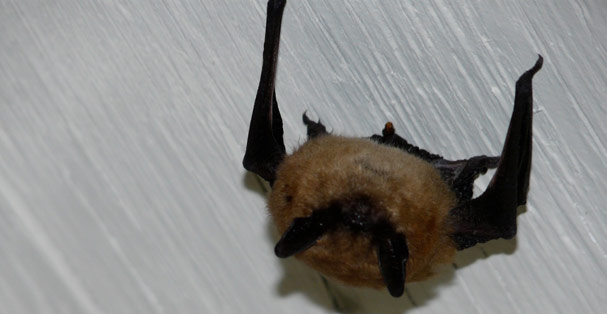
The little brown bat, an endangered species.
Bats have been a constant motif of horror stories. But today, the mysterious winged creature of gloomy nights and deep dark caves is in danger of disappearing forever.
Instead of engendering fear of blood-sucking fanged monsters that see in pitch dark, the fear is now for the bats themselves. And the monster in this story isn’t Dracula, although it thrives in chilly darkness and drains its victims of life. It’s a fungus. Pseudogymnoascus destructans causes white nose syndrome (WNS), a deadly and contagious infection that has killed millions of hibernating bats across eastern North America since 2007. No means to eradicate the fungus has been found, and WNS is coming west.
Microbiology researchers at TRU are collaborating with bat biologists in a rush to learn more about the winter habits of western hibernating bat species, and find ways to prevent or lessen the affects of the fungus before white nose syndrome arrives.
Dr. Naowarat (Ann) Cheeptham, a faculty member in Biological Sciences at TRU, has been mentoring undergraduate student researchers to study hibernacula—caves where bats hibernate in the winter—alongside her research into microorganisms from extreme cave habitats. Partnering with bat biologist and TRU adjunct professor Dr. Cori Lausen and ecologist team leader Sarah Boyle of Mount Revelstoke and Glacier National Park, Cheeptham’s students are engaging in new research to test for the presence of P. destructans in caves in the west, and gain a greater understanding of the current fungi and other microorganisms living in these caves.
“This is a great case of collaboration between microbiologists and bat biologists, as well as BC parks and the caving community, to help us understand microbial ecology that could affect aspects of bat biology in these cave habitats,” says Cheeptham.
The cold-loving P. destructans fungus attacks bats when they are most vulnerable, infecting them once they settle in caves by the hundreds or thousands, to hibernate for the winter months. Spread from bat to bat by contact, and by humans who can carry spores from cave to cave, it attacks the bat’s wing membranes, ears and muzzles, causing a white growth on the bat’s face which gives the syndrome its name. WNS is believed to cause the bat to burn through its energy reserves more quickly and then starve to death while the infection spreads to its neighbours. BC has a greater diversity of bat species than eastern Canada, and it’s not known yet how severely these species will be affected by WNS.
Last year, microbiology student Baylee Out joined a research team in Glacier National Park to collect fungus samples in the Nakimu cave system, a suspected hibernacula, for her Undergraduate Research Experience Award Program (UREAP) project. Her research, testing the samples for the presence of P. destructans, was the first study of the microbial ecology of the Nakimu caves and an attempt to detect the fungus as a preventative measure, to identify and protect hibernacula that are still uninfected.
Conservation efforts to protect the endangered little brown bat (Myotis lucifugus), northern myotis (Myotis septentrionalis) and other BC bats so far include managing access to caves by humans. Out’s fungal analysis of soil samples and environmental swabs will provide information to the park to help make decisions about allowing cavers into the Nakimu system, and a baseline of current fungi in the caves and the roles they play in cave ecology. She is currently writing a paper with Boyle and Cheeptham to share her results.
Trying to anticipate the arrival of white nose syndrome in BC is the focus of microbiology student Laura Smylie’s UREAP project, supervised by Cheeptham, Lausen and adjunct professor Dr. Ken Wagner. Smylie tested soil samples from bat hibernacula in Horne Lake Caves in BC and Rat’s Nest Cave, Alberta, which currently see high traffic from cavers and tourists who may carry fungal spores from infected caves elsewhere.
“This study conducted by TRU is part of a pioneering study with collaborators across various faculties of science, as well as participating cavers across BC,” says Smylie. Cavers collected the environmental samples, and BC and Alberta Provincial Wildlife Disease sections and the Animal Health Centre, BC Ministry of Agriculture are also partnering on the project.“From what I have found in the recent literature, culturing P. destructans spores from environmental soil samples to try and monitor the spread of the fungus has not been something previously investigated. Being part of such a unique research study during my undergraduate degree is an incredible and exciting experience.”
While Smylie’s research will help identify uninfected caves to be protected, student Mitchell Johnson is investigating environmental factors that may influence the winter activity of some species of bats, differences in behaviour that could be an advantage to BC species soon faced with WNS in their caves.
This is the time of year when bats are making their way to winter roosts. Observing winter behaviour of western bats is critical to learning how to prevent WNS from decimating bat populations here as it has in the east, so biologists urge the public to report winter sightings of bats to the Wildlife Conservation Society Canada (clausen@wcs.org) or the BC Bat Action Taskforce (bcbats@gmail.com).


